The VIRTUALDiver Project. Making Greece’s Underwater Cultural Heritage Accessible to the Public
Abstract
1. Introduction
2. Interaction Components and Methods
- (1)
- Proper visualization of the type of media that the tool will manage through a representative icon (e.g., image thumbnail icon),
- (2)
- The use of a title and a related auxiliary summary that will explain the properties of the POI, and
- (3)
- The selection and attachment of the interaction tools through drop-down menus in order to form the narrative scenarios for each landmark.
- Section 1: Basic information about the tool and the POI, such as tool type, unique POI code, name, coordinates, and basic tag, as well as the instructions for use.
- Section 2: Enables the automatic import of data from the data collection and processing stage.
- Section 3: This is the main part of the tool and provides the ability to insert new data as well as to configure the existing one. Concerning the Image Component tool, photos are inserted, and provided fields correspond to the photo, title, and description.
- Section 4: Enables the function of saving changes to the database.
- Section 5: Consists of a comment field. Comments are stored in the database and are visible to all members of the design team who use the platform.
- Consistency in the presentation of content in various media.
- Design solutions that facilitate the ways of interaction in both VR glasses and a conventional computer screen, as well as in smaller screens.
- Color combinations that facilitate the readability of graphics for use in various media.
- Selection of typographic elements, font family, and auxiliary icons that offer optimal readability and ease of interaction in various media.
3. Results and Discussion
3.1. The Platform
3.1.1. Interdisciplinarity
- Scientific disciplines of geology,
- Humanities with an emphasis on culture (archaeology, history, museology, etc.),
- Disciplines of theoretical and practical issues of design, audio, and video arts,
- Information and communication technologies,
- Other scientific fields that may make a useful contribution, depending on the design strategy.
3.1.2. The Product
3.1.3. System’s Architecture
- (1)
- The data collection subsystem is based on internet technologies and aims at creating, processing, and maintaining the data prototypes required for subsequent use by the interaction and experience design subsystem. Through this subsystem, the user is able to upload all the necessary multimedia material to a database in order to create interactive experiences.
- (2)
- The subsystem of interaction, experience design, and content presentation uses the capabilities provided by Unity 3D development platform, to design and present interactive experiences. For this purpose, techniques and tools for interaction with multimedia content are developed to facilitate the design team in the production process of interactive narratives. Through simplified procedures, the design team is able to incorporate the necessary multimedia initially imported in the data collection subsystem, as well as the respective geomorphological terrain into the software. As a result, the design team is able to create various types of interactive experiences based on pre-designed paths. Depending on the design that is followed for the interactive experience, the final result can be exported to the corresponding medium (VR goggles, tablets, etc.). The key element of the platform is that it provides mechanisms for the implementation of interactive experiences with dynamic content, separating the collection and configuration of multimedia material from the development and visualization of the interactive experience. It also enables the sustained updating and processing of the multimedia material by the design team, according to the requirements and needs of the customer-user as well as the design specifications that have been set or updated. The subsystem of interaction, experience planning, and content presentation provides the design team with the following capabilities:
- Multiple ways of interacting with the content, such as slideshow, panoramic photos, videos, audio clips, text, timeline, specially designed museo-pedagogical applications, etc.
- Multiple ways of presenting the content, such as Virtual Maps, Routes, Geographical Areas, Through Thematic Categories, etc.
- Future expansion and additions, without necessary changes in the existing material.
3.2. Santorini Case Study
- Natural objects such as stones, sand, tree trunks, shells
- Objects of the external environment
- Flora and fauna such as various species of fish, sea turtles, sea urchins, jellyfish, various species of algae, coral
- Objects of particular interest such as shipwrecks, rocks of geological value, and objects of narrative interest.
3.3. Discussion
4. Conclusions
- Easy navigation in the virtual environment.
- Easy access to content.
- Ability to navigate using digital maps (2D and 3D).
- Ability to navigate using virtual routes.
- Attractive interfaces of interactive experiences.
Supplementary Materials
Author Contributions
Funding
Acknowledgments
Conflicts of Interest
Abbreviations
| AR | Augmented Reality |
| VR | Virtual Reality |
| UCH | Underwater Cultural Heritage |
| POI | Point of Interest |
| VRTK | Virtual Reality Tool Kit |
| UI | User Interface |
| UX | User Experience |
| GUI | Graphical User Interface |
| ICT | Information and Communication Technologies |
| NVMe | Non Volatile Memory Express |
| SSD | Solid State Drive |
References
- Aylett, R. Narrative in Virtual Environments—Towards Emergent Narrative. In Proceedings of the AAAI Fall Symposium on Narrative Intelligence, Orlando, FL, USA, 18–22 July 1999; pp. 83–86. [Google Scholar]
- Brooks, K. There is Nothing Virtual about Immersion: Narrative Immersion for VR and Other Interfaces. 2003. Available online: http://alumni.media.mit.edu/~brooks/storybiz/immersiveNotVirtual.pdf (accessed on 5 October 2020).
- Koenitz, H. Towards a Theoretical Framework for Interactive Digital Narrative. In Proceedings of the Interactive Storytelling—Third Joint Conference on Interactive Digital Storytelling, ICIDS 2010, Edinburgh, UK, 1–3 November 2010; pp. 176–185. [Google Scholar] [CrossRef]
- Koenitz, H. Five Theses for Interactive Digital Narrative. Lecture Notes in Computer Science. In Proceedings of the International Conference on Interactive Digital Storytelling, Singapore, 3–6 November 2014; pp. 134–139. [Google Scholar] [CrossRef]
- Koenitz, H. Towards a Specific Theory of Interactive Digital Narrative. In Interactive Digital Narrative. History Theory Practice; Routledge: London, UK, 2015. [Google Scholar]
- Koenitz, H.; Sezen, T.I.; Ferri, G.; Haahr, M.; Sezen, D.; Çatak, G. Interactive Storytelling. In Proceedings of the 6th International Conference, ICIDS 2013, Istanbul, Turkey, 6–9 November 2013; Springer: Berlin/Heidelberg, Germany, 2013. [Google Scholar]
- Çizel, B.; Ajanovic, E. Virtual Reality for Cultural Heritage Tourism. In Proceedings of the 4th International Scientific Conference—SITCON 2018, Belgrade, Serbia, 12 October 2018; pp. 131–134. [Google Scholar] [CrossRef]
- Varinlioglu, G. Digital in Underwater Cultural Heritage; Cambridge Scholars Publishing: Cambridge, UK, 2016; p. 108. [Google Scholar]
- Bruno, F.; Barbieri, L.; Muzzupappa, M.; Tusa, S.; Fresina, A.; Oliveri, F.; Lagudi, A.; Cozza, A.; Peluso, R. Enhancing learning and access to Underwater Cultural Heritage through digital technologies: The case study of the “Cala Minnola” shipwreck site. Digit. Appl. Archaeol. Cult. Herit. 2019, 13, e00103. [Google Scholar] [CrossRef]
- Beltrame, C.; Costa, E. 3D survey and modelling of shipwrecks in different underwater environments. J. Cult. Herit. 2018, 29, 82–88. [Google Scholar] [CrossRef]
- Magrini, M.; Moroni, D.; Pascali, M.A.; Reggiannini, M.; Salvetti, O.; Tampucci, M. Virtual environment as a tool to access the marine abysses. In Proceedings of the MTS/IEEE OCEANS 2015 Conference, Genova, Italy, 18–21 May 2015; pp. 1–5. [Google Scholar]
- Bruno, F.; Lagudi, A.; Muzzupappa, M.; Lupia, M.; Cario, G.; Barbieri, L.; Passaro, S.; Saggiomo, R. Project VISAS: Virtual and Augmented Exploitation of Submerged Archaeological Sites-Overview and First Results. Mar. Technol. Soc. J. 2016, 50, 119–129. [Google Scholar] [CrossRef]
- Bruno, F.; Barbieri, L.; Lagudi, A.; Cozza, M.; Cozza, A.; Peluso, R.; Muzzupappa, M. Virtual dives into the underwater archaeological treasures of South Italy. Virtual Real. 2018, 22, 91–102. [Google Scholar] [CrossRef]
- Bruno, F.; Lagudi, A.; Ritacco, G.; Agrafiotis, P.; Skarlatos, D.; Čejka, J.; Kouril, P.; Liarokapis, F.; Philpin-Briscoe, O.; Poullis, C.; et al. Development and integration of digital technologies addressed to raise awareness and access to European underwater cultural heritage. An overview of the H2020 i-MARECULTURE project. In OCEANS 2017-Aberdeen; IEEE: Piscataway, NJ, USA, 2017. [Google Scholar] [CrossRef]
- Scaradozzi, D.; Bruno, F.; Zingaretti, S.; Panebianco, L.; Ciuccoli, N.; Screpanti, L.; Ritacco, G. The Lab4Dive Project: A mobile smart lab for augmented archaeological dives-overview and first results. In Proceedings of the IMEKO International Conference on Metrology for Archaeology and Cultural Heritage, Lecce, Italy, 23–25 October 2017. [Google Scholar]
- Scaradozzi, D.; Zingaretti, S.; Ciuccoli, N.; Costa, D.; Palmieri, G.; Bruno, F.; Ritacco, G.; Cozza, M.; Raxis, P.; Tzifopanopoulos, A.; et al. Lab4Dive Mobile Smart Lab for Augmented Archaeological Dives. IOP Conf. Ser. Mater. Sci. Eng. 2018, 364, 012054. [Google Scholar] [CrossRef]
- Haydar, M.; Maidi, M.; Roussel, D.; Mallem, M.; Drap, P.; Bale, K.; Chapman, P. Virtual Exploration of Underwater Archaeological Sites: Visualization and Interaction in Mixed Reality Environments. In Proceedings of the 9th International Symposium on Virtual Reality, Archaeology and Cultural Heritage, Braga, Portugal, 2–5 December 2008; pp. 141–148. [Google Scholar] [CrossRef]
- Haydar, M.; Roussel, D.; Maïdi, M.; Otmane, S.; Mallem, M. Virtual and augmented reality for cultural computing and heritage: A case study of virtual exploration of underwater archaeological sites (preprint). Virtual Real. 2011, 15, 311–327. [Google Scholar] [CrossRef]
- Wevr. Available online: https://wevr.com/project/theblu-deep-rescue (accessed on 17 November 2020).
- Ocean Maps. Available online: https://www.ocean-maps.com/en/oeffentliche-apps/ (accessed on 17 November 2020).
- The Virtual Museum Underwater Malta. Available online: https://underwatermalta.org/ (accessed on 17 November 2020).
- 360 Virtual Tour. Available online: https://www.360virtualtour.co/portfolio/underwater-ocean-coral-reef-virtual-tour/ (accessed on 17 November 2020).
- Bruno, F.; Lagudi, A.; Barbieri, L.; Muzzupappa, M.; Mangeruga, M.; Cozza, M.; Cozza, A.; Ritacco, G.; Peluso, R. Virtual Reality Technologies for the Exploitation of Underwater Cultural Heritage. In Latest Developments in Reality-Based 3D Surveying and Modelling; MDPI: Basel, Switzerland, 2018. [Google Scholar] [CrossRef]
- Bruno, F.; Lagudi, A.; Barbieri, L.; Muzzupappa, M.; Mangeruga, M.; Pupo, F.; Cozza, M.; Ritacco, G.; Peluso, R.; Tusa, S. Virtual diving in the underwater archaeological site of cala minnola. ISPRS Int. Arch. Photogramm. Remote. Sens. Spat. Inf. Sci. 2017, 2, 121–126. [Google Scholar] [CrossRef]
- Fazullin, S.; Gorlov, I.; Tkachenko, Y.; Khokhlov, S.; Bardashov, M.; Sadekov, R. Creation of a virtual museum and a diving park east of the island of Lemnos on the site of the wreck of the Svyatoslav ship. In Proceedings of the International Conference in Management of Accessible Underwater, Cultural and Natural Heritage Sites: “Dive in Blue Growth”, Athens, Greece, 16–18 October 2019. [Google Scholar]
- Bruno, F.; Lagudi, A.; Collina, M.; Medaglia, S.; Kalamara, P.; Kourkoumelis, D.; Nad, D.; Kapetanovic, N.; Markovic, M.; Miskovic, N. Opto-acoustic 3D Reconstruction and Virtual Diving on the Peristera Shipwreck. In Proceedings of the International Conference in Management of Accessible Underwater, Cultural and Natural Heritage Sites: “Dive in Blue Growth”, Athens, Greece, 16–18 October 2019; Available online: https://bluemed.interreg-med.eu/international-conference/ (accessed on 5 October 2020).
- Petriaggi, B.D.; Michele Stefanile, M.; D’Agostino, M.; Ricci, S.; Perasso, S. MUSAS: An innovative project for the enhancement of the Underwater Cultural Heritage. In Proceedings of the International Conference in Management of Accessible Underwater, Cultural and Natural Heritage Sites: “Dive in Blue Growth”, Athens, Greece, 16–18 October 2019; Available online: https://bluemed.interreg-med.eu/international-conference/ (accessed on 5 October 2020).
- Bruno, F.; Cozza, M.; Mangeruga, M.; Skarlatos, D.; Agrafiotis, P.; Petriaggi, B.D.; Petriaggi, R.; Rizvic, S.; Liarokapis, F. Raising the awareness about underwater archaeological heritage through Edutainment and Virtual/Augmented Reality. In Proceedings of the International Conference in Management of Accessible Underwater, Cultural and Natural Heritage Sites: “Dive in Blue Growth”, Athens, Greece, 16–18 October 2019; Available online: https://bluemed.interreg-med.eu/international-conference/ (accessed on 5 October 2020).
- Nomikou, P.; Karantzalos, K.; Ioannidis, G.; Sarantinos, M.; El Saer, A.; Stentoumis, C.; Kalisperakis, I.; Antoniou, V.; Pehlivanides, G.; Tsoris, P.; et al. VirtualDIVER: An innovative platform for virtual underwater experiences targeting the cultural and tourism industries. In Proceedings of the EGU2019 Conference, Vienna, Austria, 7–12 April 2019; Volume 21. EGU2019-10638-1. [Google Scholar]
- Nomikou, P.; Pehlivanides, G.; El Saer, A.; Karantzalos, K.; Stentoumis, C.; Bejelou, K.; Antoniou, V.; Douza, M.; Vlasopoulos, O.; Monastiridis, K.; et al. Novel Virtual Reality Solutions for Captivating Virtual Underwater Tours Targeting the Cultural and Tourism Industries. In Proceedings of the 6th International Conference on Geographical Information Systems Theory, Applications and Management, Prague, Czech Republic, 7–9 May 2020; Volume 1, pp. 7–13, ISBN 978-989-758-425-1. [Google Scholar] [CrossRef]
- National and Kapodistrian University of Athens, Faculty of Geology and Geoenvironment. Available online: https://en.geol.uoa.gr/ (accessed on 17 November 2020).
- TETRAGON SA—TETRAGON Home | TETRAGON. Available online: http://tetragon.gr/en/home/ (accessed on 17 November 2020).
- Up2metric, P. C—Up2Metric Up2Metric | Computer Vision Engineering. Available online: http://www.up2metric.com (accessed on 17 November 2020).
- Steficon SA—Steficon Steficon S.A. | Digital Marketing & Communication Agency. Available online: https://www.steficon.gr (accessed on 17 November 2020).
- Unity 3D Software—Unity3D 2019.4.0f1, Unity Technologies, San Francisco, CA, US, 2004, Website: Unity 3D Unity Technologies. Available online: https://www.unity.com (accessed on 17 November 2020).
- Processor Intel Core, version i7-8700; Intel Corporation: Santa Clara, CA, USA, 2018.
- AMD Ryzen 7,2700; Advanced Micro Devices, Inc. (AMD): Santa Clara, CA, USA, 2017.
- NVIDIA GeForce RTX 2080, NVIDIA Quadro RTX 6000; Nvidia Corporation: Santa Clara, CA, USA, 2018.
- Oculus Rift S; Facebook Technologies LLC: Menlo Park, CA, USA, 2019.
- Windows 10 (64-bit); Microsoft Corporation: Redmond, WA, USA, 2015.
- El Saer, A.; Stentoumis, C.; Kalisperakis, I.; Nomikou, P. Developing a strategy for precise 3D modelling of large-scale scenes for VR. ISPRS Int. Arch. Photogramm. Remote. Sens. Spat. Inf. Sci. 2020, 567–574. [Google Scholar] [CrossRef]
- El Saer, A.; Stentoumis, C.; Kalisperakis, I.; Grammatikopoulos, L.; Nomikou, P.; Vlasopoulos, O. 3D reconstruction and mesh optimization of underwater spaces for virtual reality. ISPRS Int. Arch. Photogramm. Remote. Sens. Spat. Inf. Sci. 2020, 949–956. [Google Scholar] [CrossRef]
- VRTK-VRTK 3 3; Website: VRTK-VRTK-Virtual Reality Toolkit; Extend Reality Ltd.: Evesham, UK, 2019; Available online: https://www.vrtk.io (accessed on 17 November 2020).
- Oculus. Available online: https://www.oculus.com/rift-s/ (accessed on 17 November 2020).
- Playmaker-Playmaker v1 9.0; Website: Playmaker. Hutonggames; Hutong Games: North Adams, MA, USA, 2011; Available online: https://hutonggames.com/showcase.html (accessed on 17 November 2020).
- Kappel, G.; Vitek, J.; Nierstrasz, O.; Gibbs, S.; Junod, B.; Stadelmann, M.; Tsichritzis, D. An Object-Based Visual Scripting Environment 1989, 123–142. Available online: https://www.academia.edu/32896590/An_Object_Based_Visual_Scripting_Environment (accessed on 17 November 2020).
- PSD2GUI-Psd 2 uGUI Pro 3.4.0 auiWorks. Available online: https://assetstore.unity.com/packages/tools/gui/psd-2-ugui-pro-16131#releases (accessed on 17 November 2020).
- Adobe. Available online: https://www.adobe.com/gr_en/products/photoshop.html (accessed on 17 November 2020).
- Guerron, E. Oculus—Dash Virtual Desktop. Available online: http://www.eliguerron.com/oculus-dash-virtual-desktop (accessed on 17 November 2020).
- Hooft, E.E.E.; Nomikou, P.; Toomey, D.R.; Lampridou, D.; Getz, C.; Christopoulou, M.-E.; O’Hara, D.; Arnoux, G.M.; Bodmer, M.; Gray, M.; et al. Backarc tectonism, volcanism, and mass wasting shape seafloor morphology in the Santorini-Christiana-Amorgos region of the Hellenic Volcanic Arc. Tectonophysics 2017, 712–713, 396–414. [Google Scholar] [CrossRef]
- Nomikou, P.; Papanikolaou, D.; Alexandri, M.; Sakellariou, D.; Rousakis, G. Submarine volcanoes along the Aegean volcanic arc. Tectonophysics 2013, 123–146. [Google Scholar] [CrossRef]
- Bozgeyikli, E.; Bozgeyikli, L.; Raij, A.; Katkoori, S.; Alqasemi, R.; Dubey, R. Virtual Reality Interaction Techniques for Individuals with Autism Spectrum Disorder: Design Considerations and Preliminary Results. In Proceedings of the International Conference on Human-Computer Interaction, Toronto, ON, Canada, 17–22 July 2016; pp. 127–137. [Google Scholar] [CrossRef]
- So, R.H.; Lo, W.T.; Ho, A.T.K. Effects of Navigation Speed on Motion Sickness Caused by an Immersive Virtual Environment. Hum. Factors J. Hum. Factors Ergon. Soc. 2001, 43, 452–461. [Google Scholar] [CrossRef] [PubMed]
- Kourtesis, P.; Korre, D.; Collina, S.; Doumas, L.A.A.; MacPherson, S.E. Guidelines for the Development of Immersive Virtual Reality Software for Cognitive Neuroscience and Neuropsychology: The Development of Virtual Reality Everyday Assessment Lab (VR-EAL), a Neuropsychological Test Battery in Immersive Virtual Reality. Front. Comput. Sci. 2020, 1. [Google Scholar] [CrossRef]
- Photoshop—Adobe Photoshop (version); Adobe Inc.: San Jose, CA, USA, 1990.
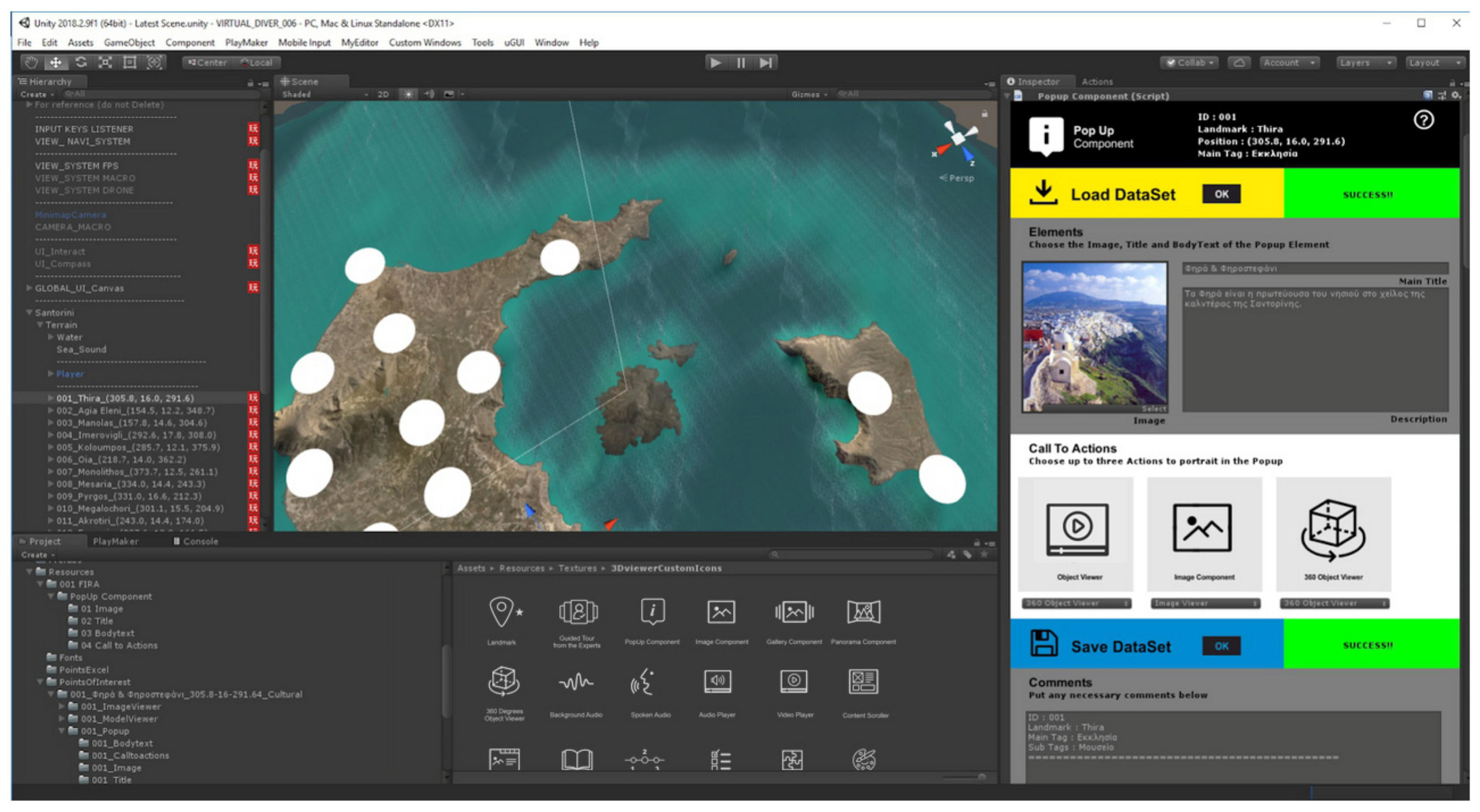
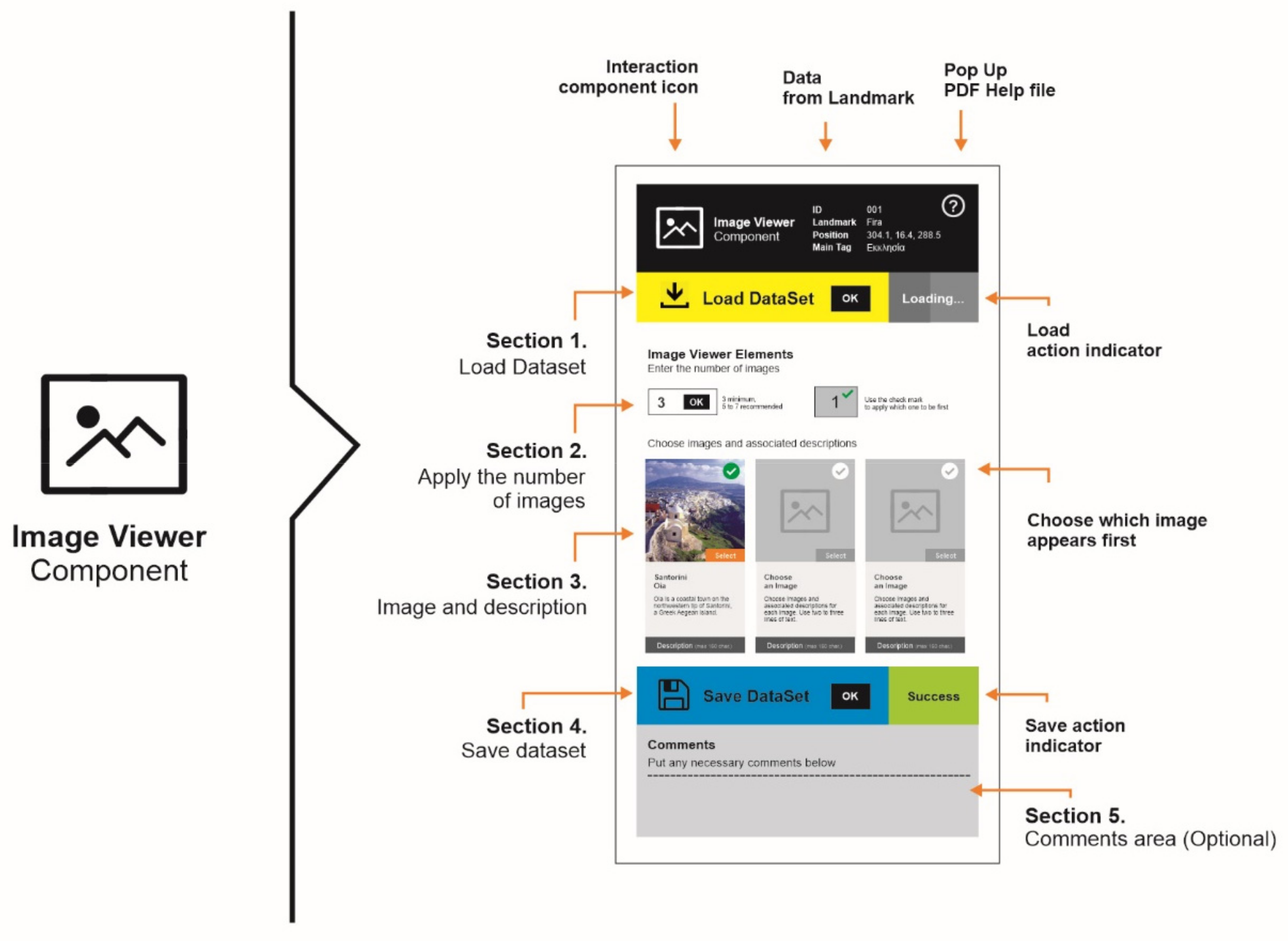
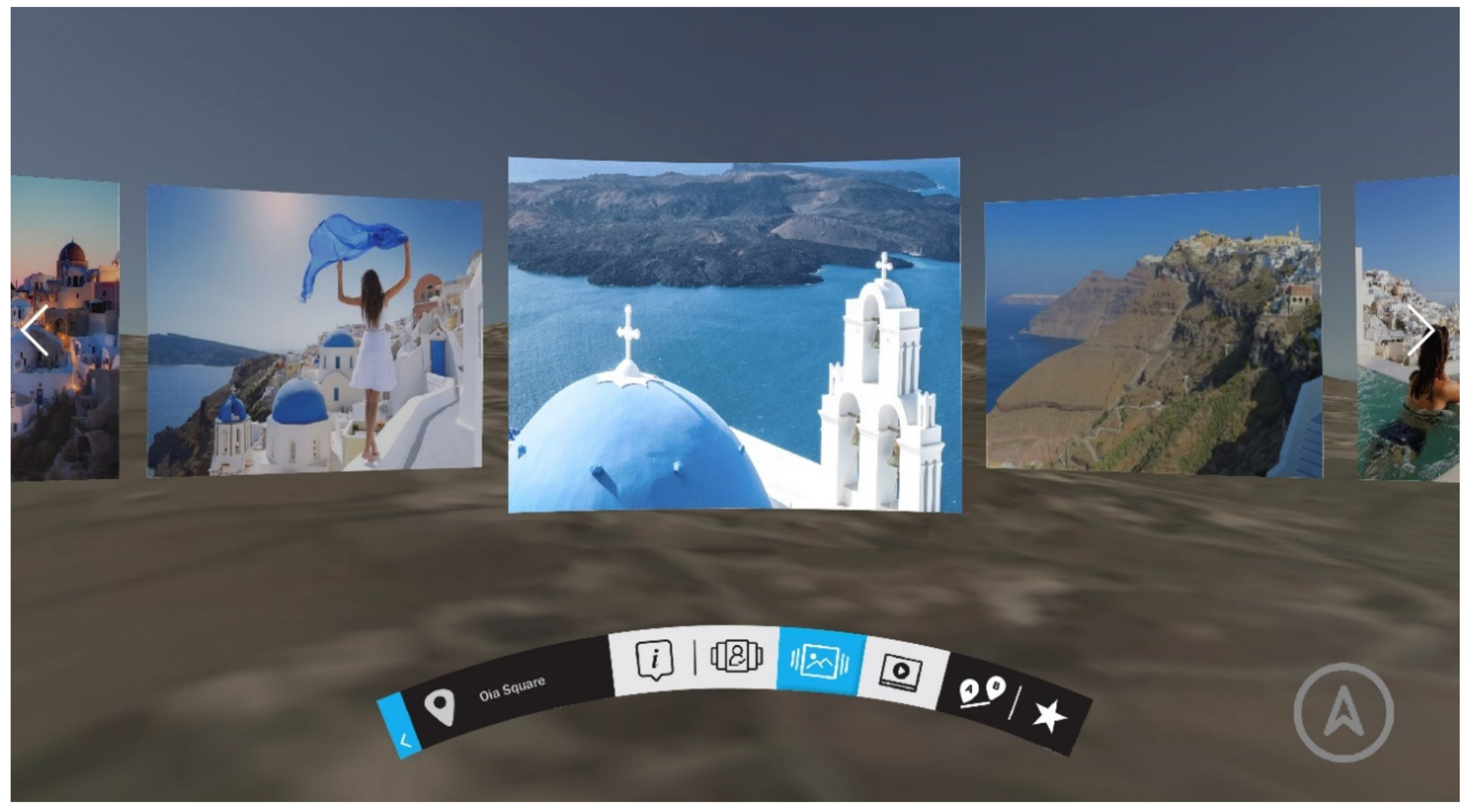

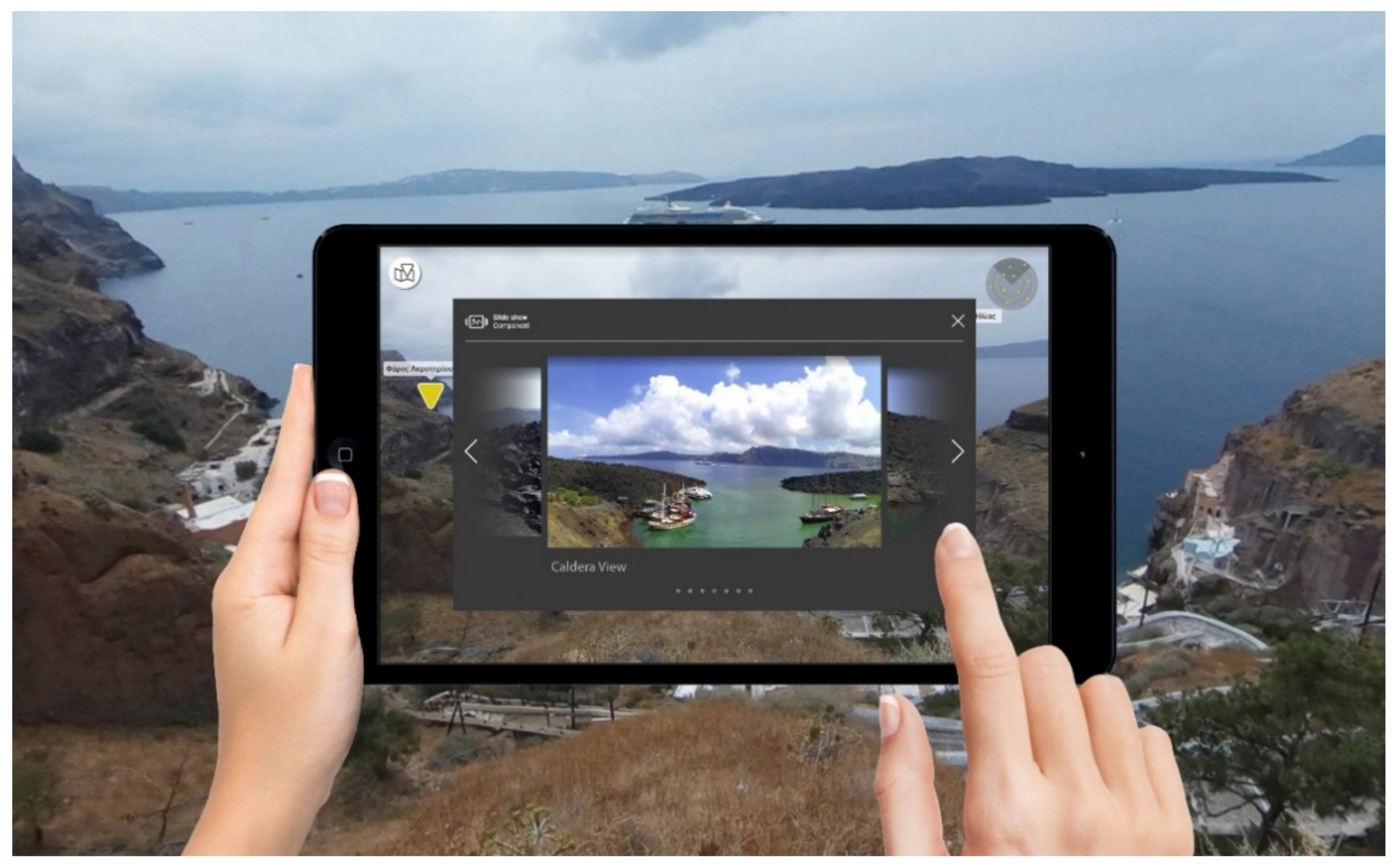
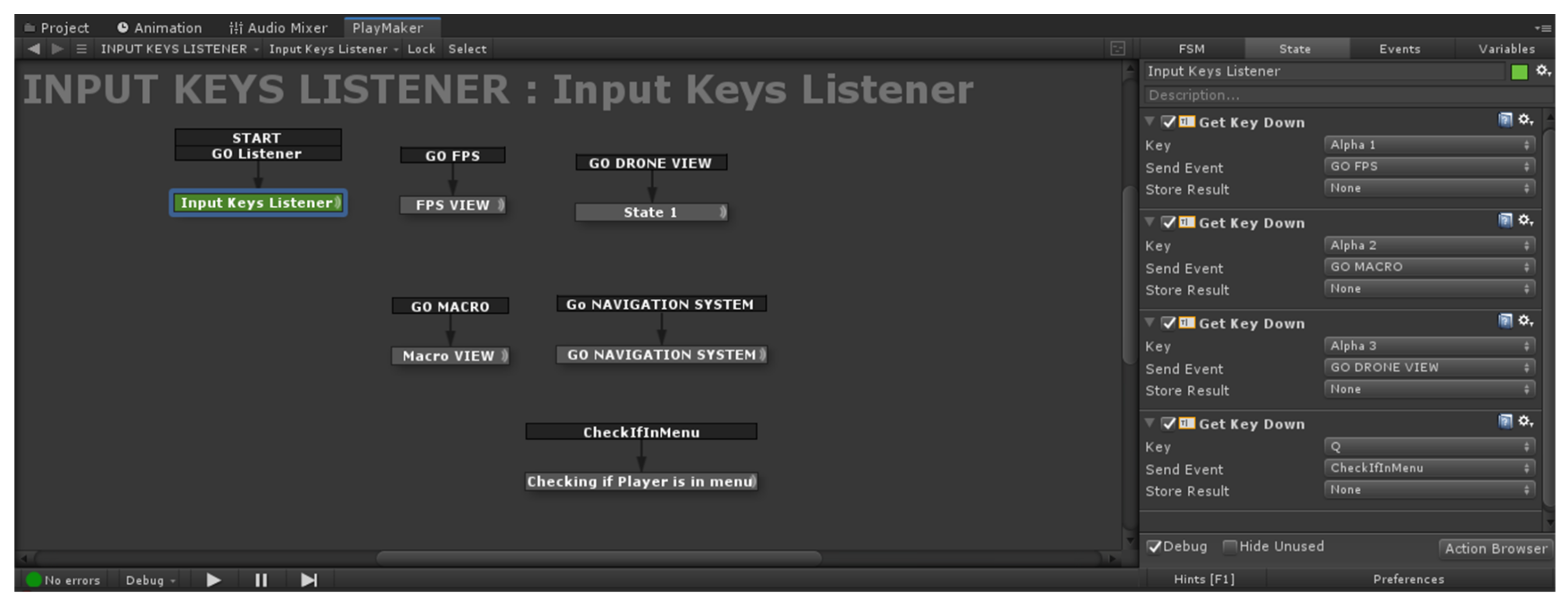
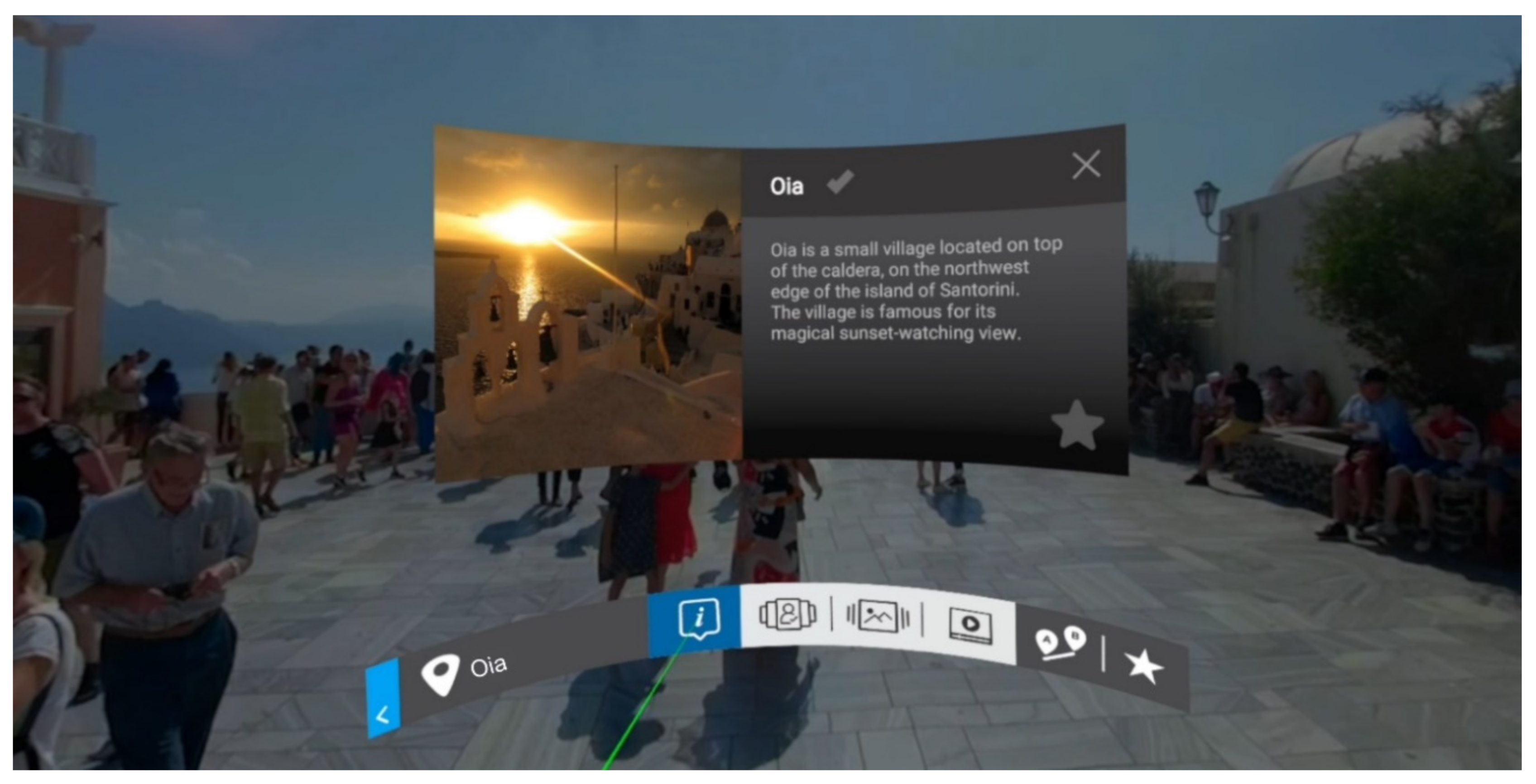
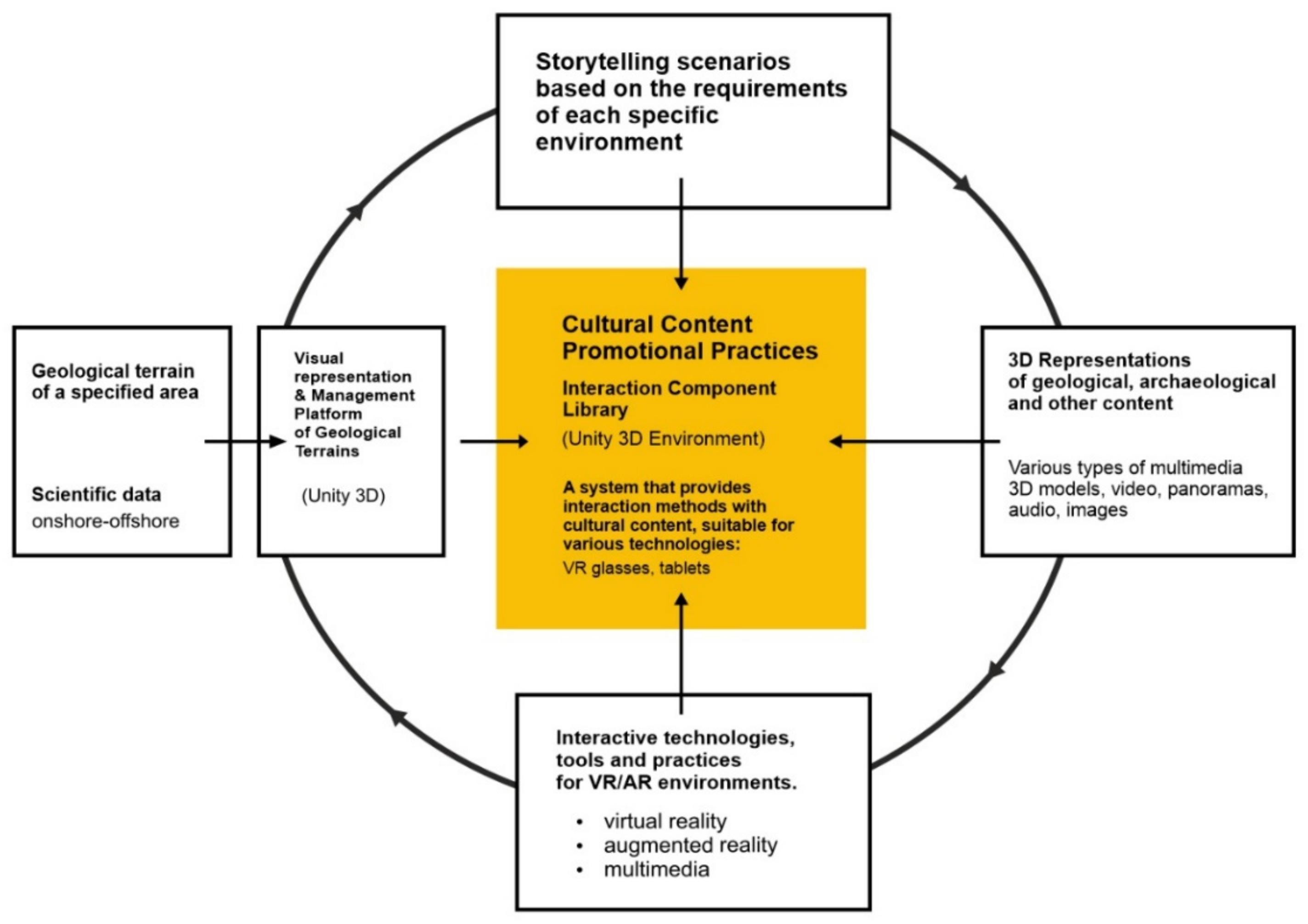
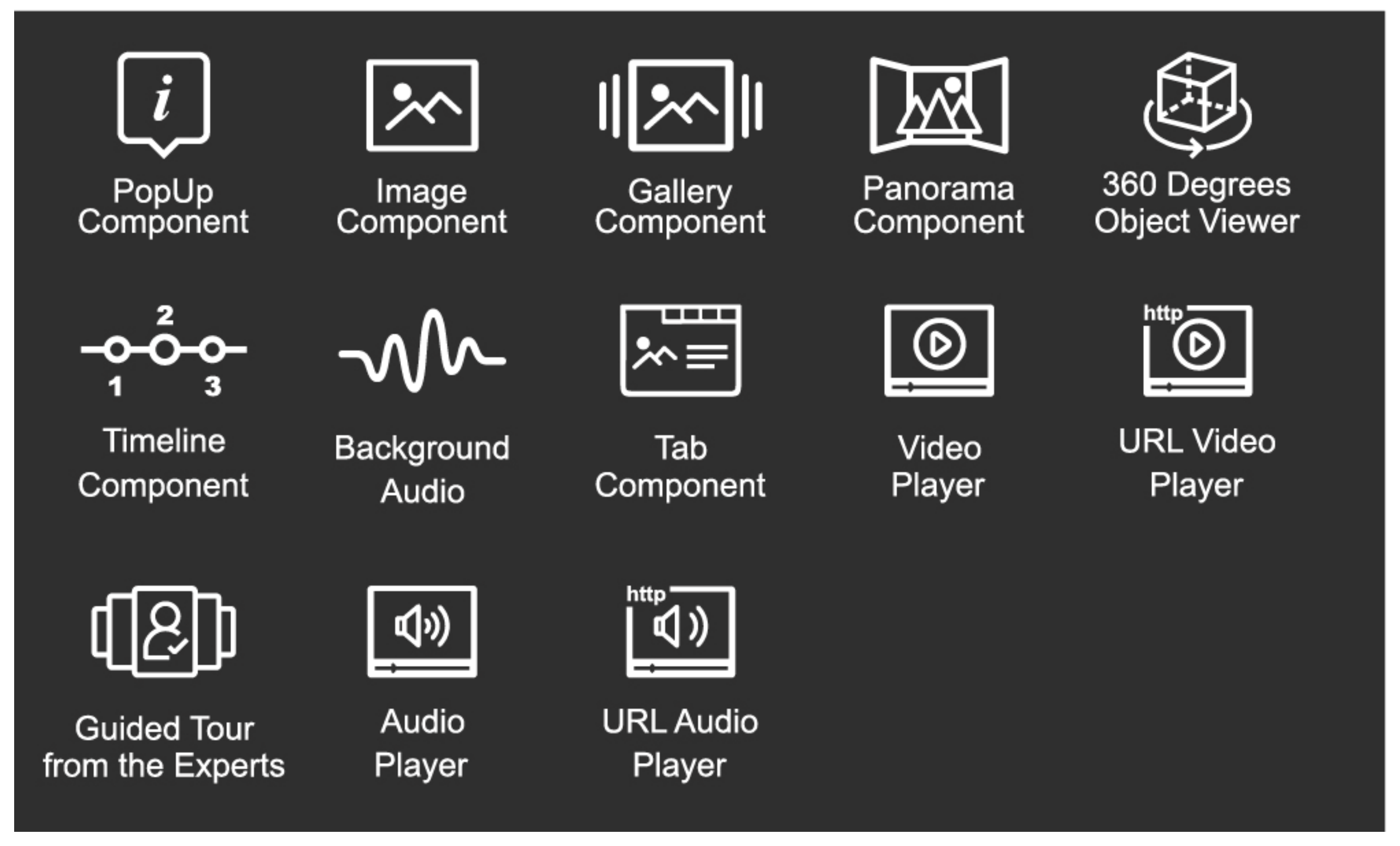
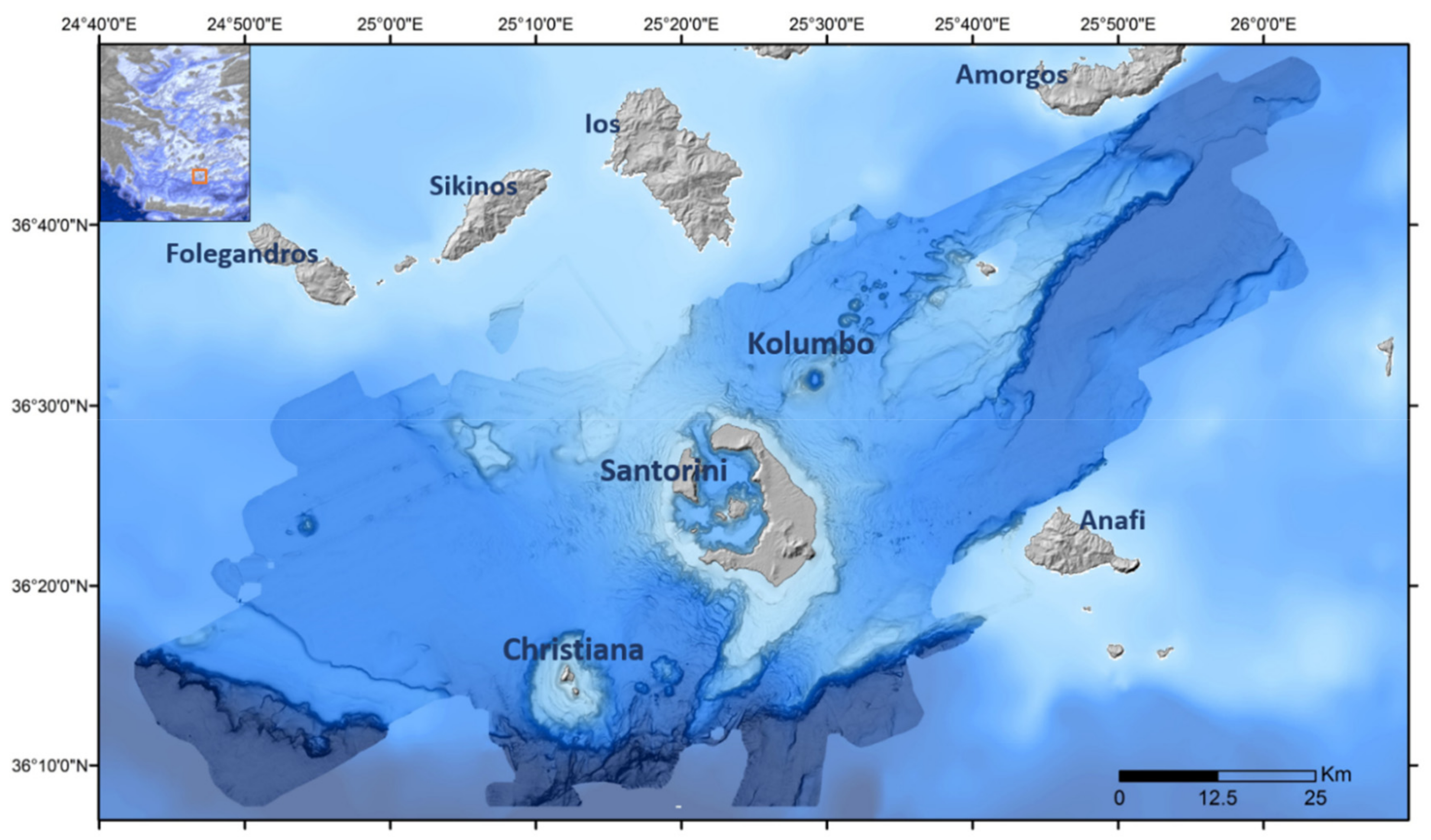
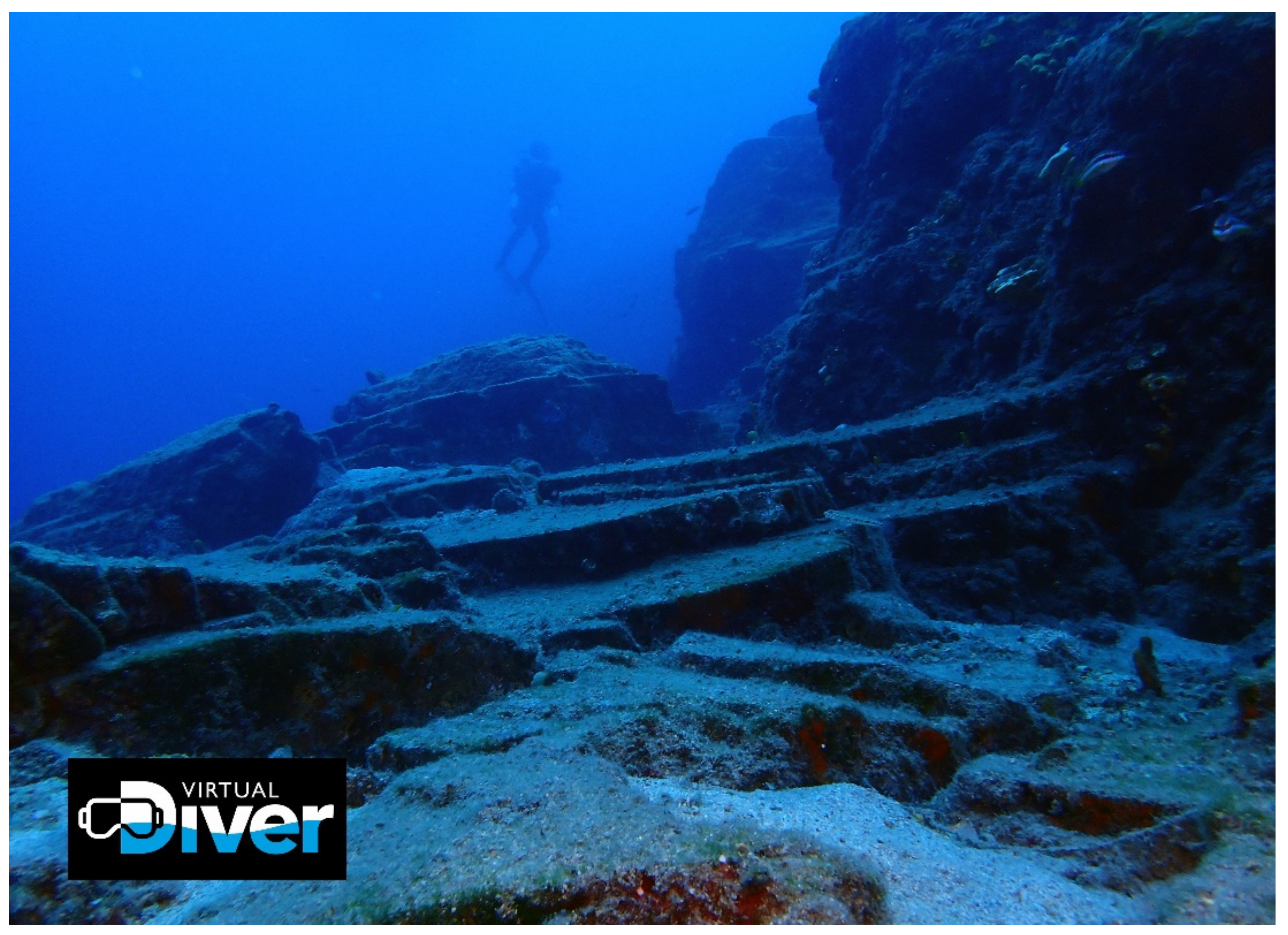
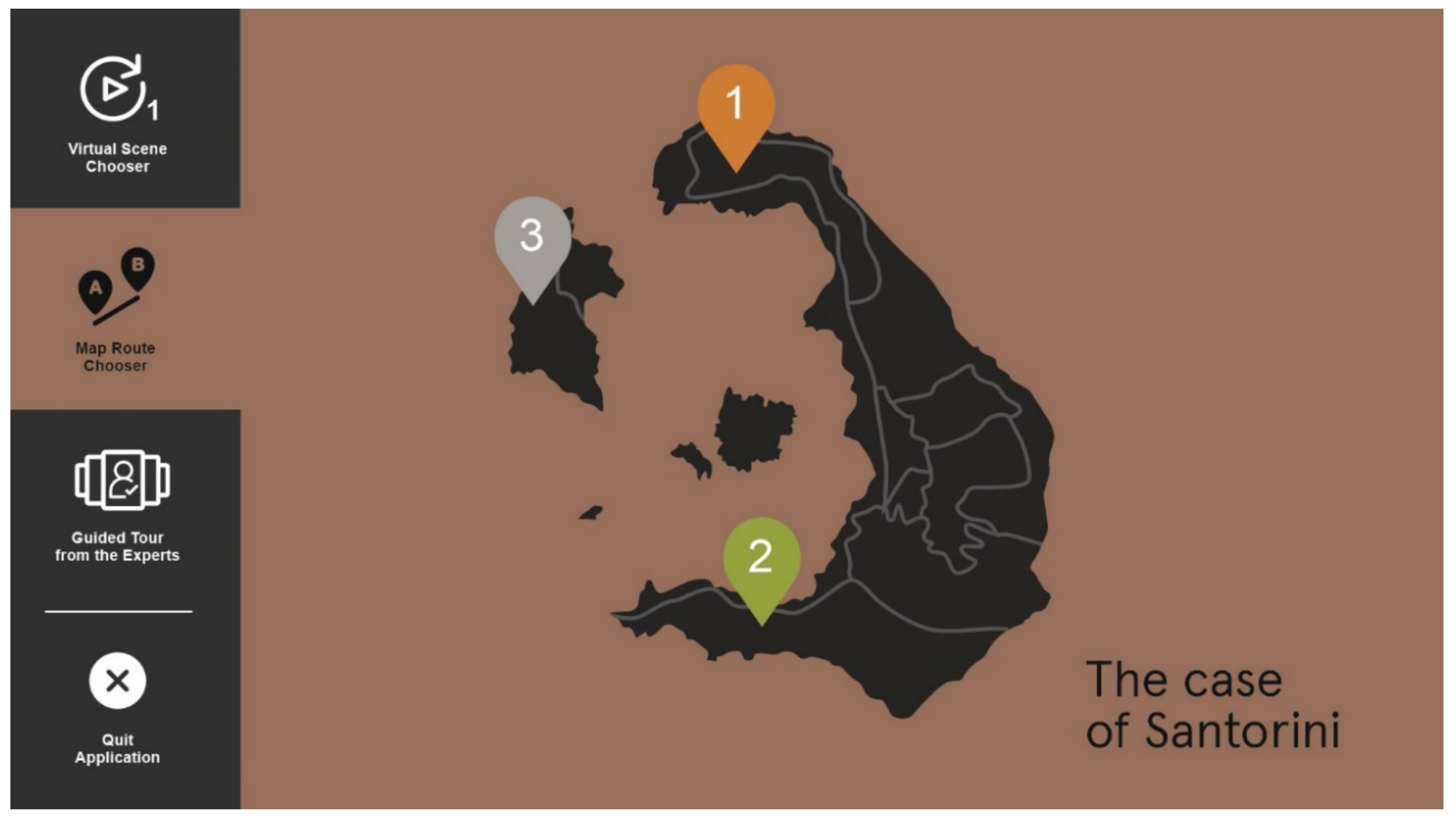
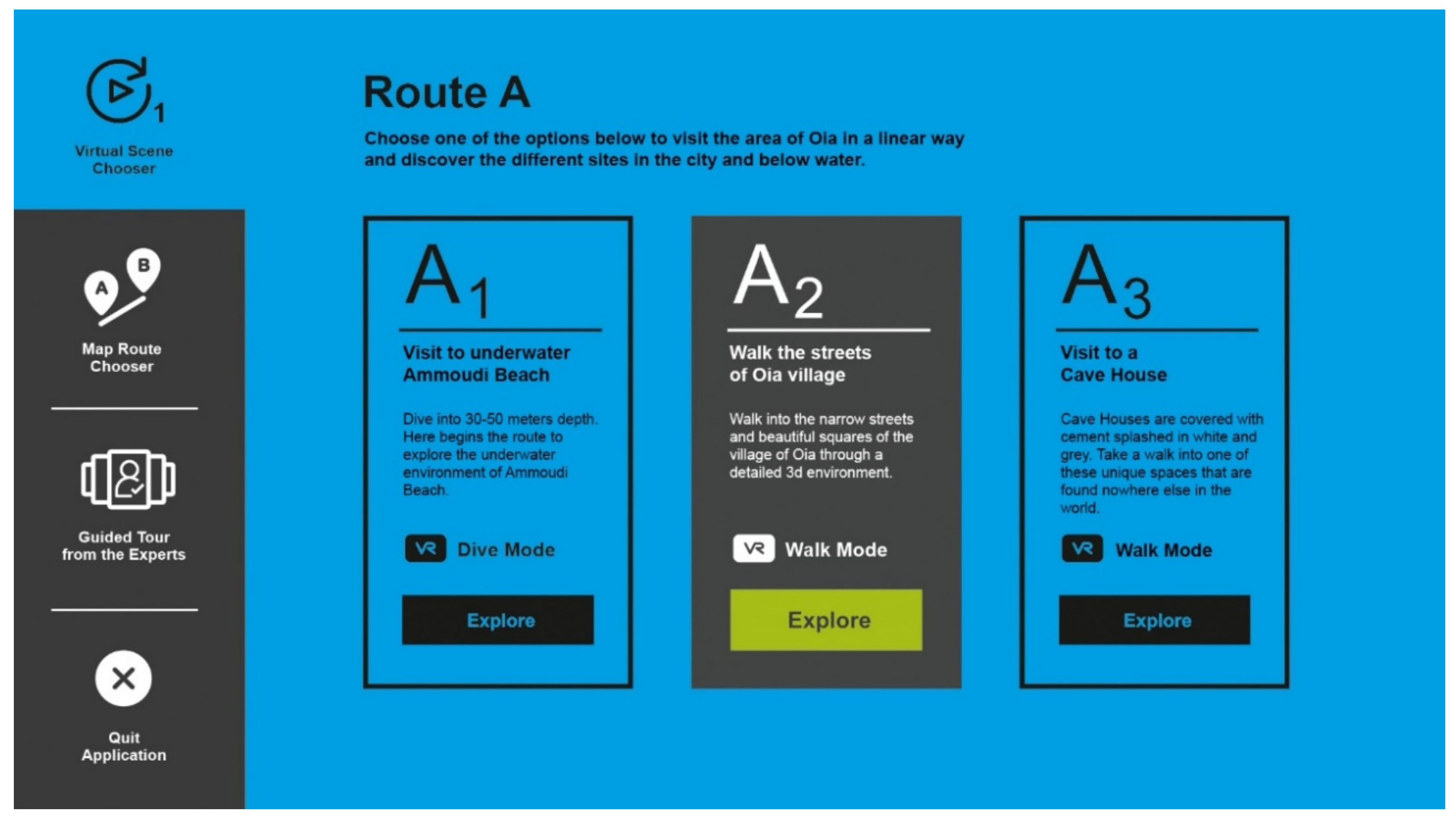
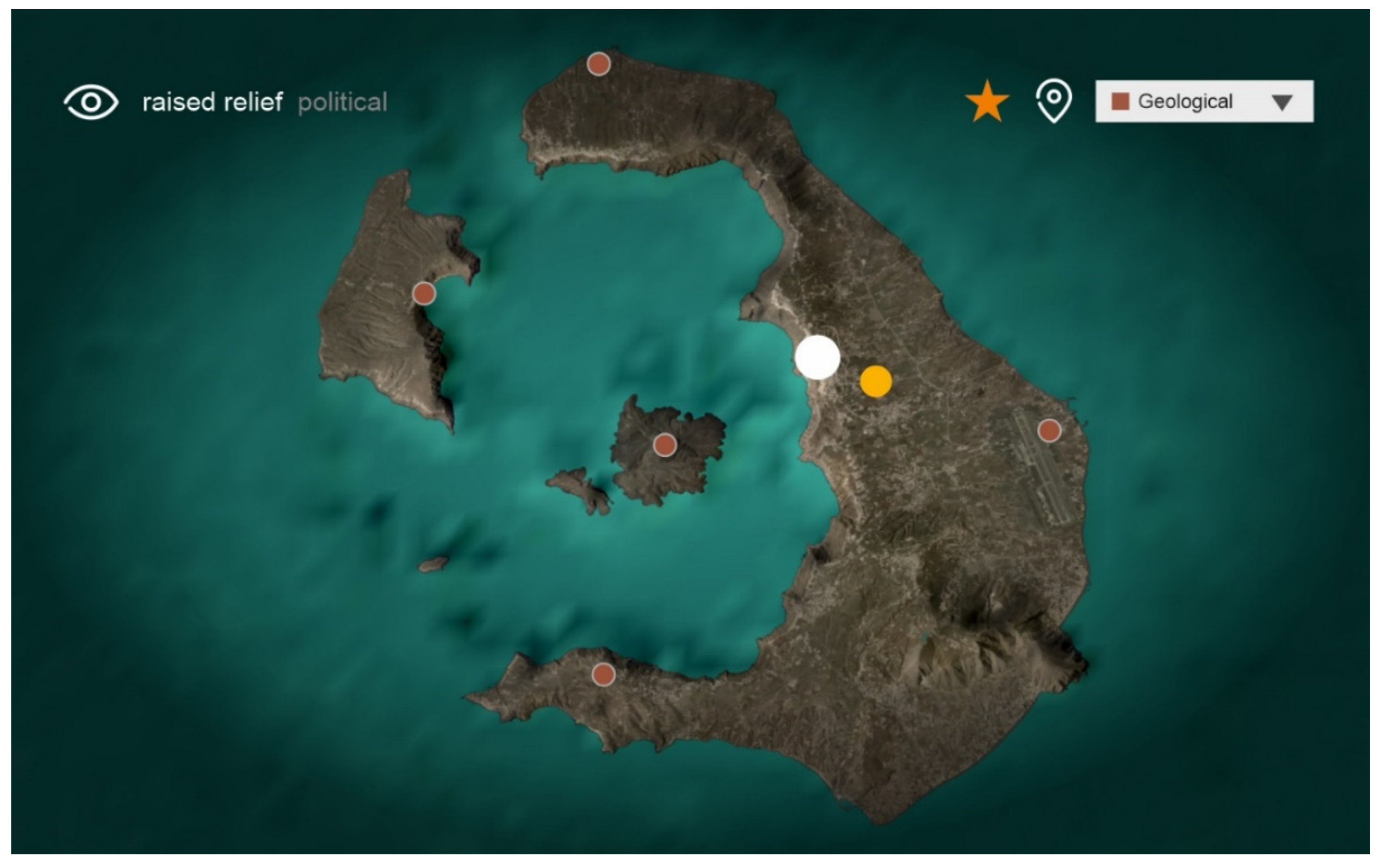
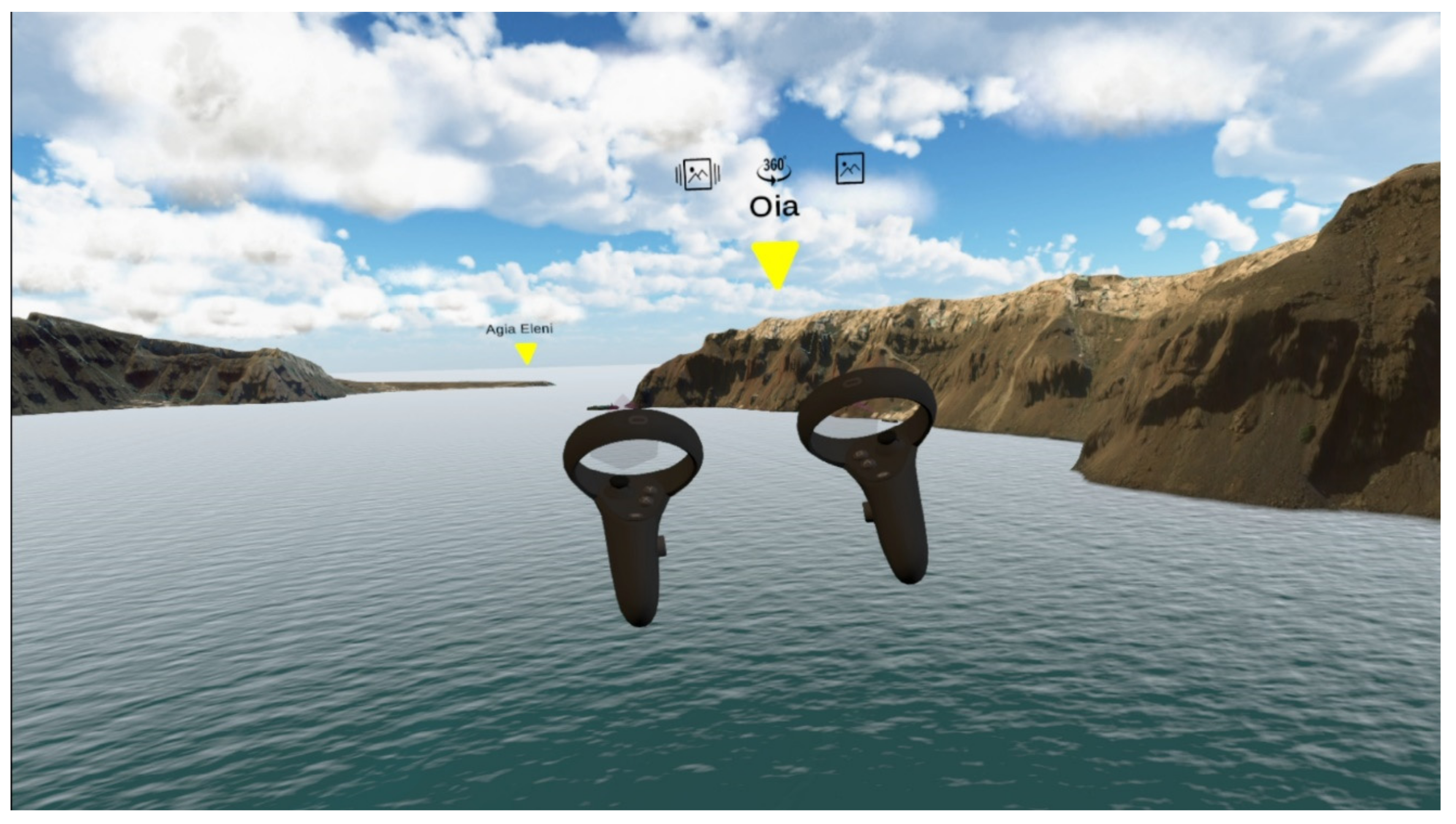
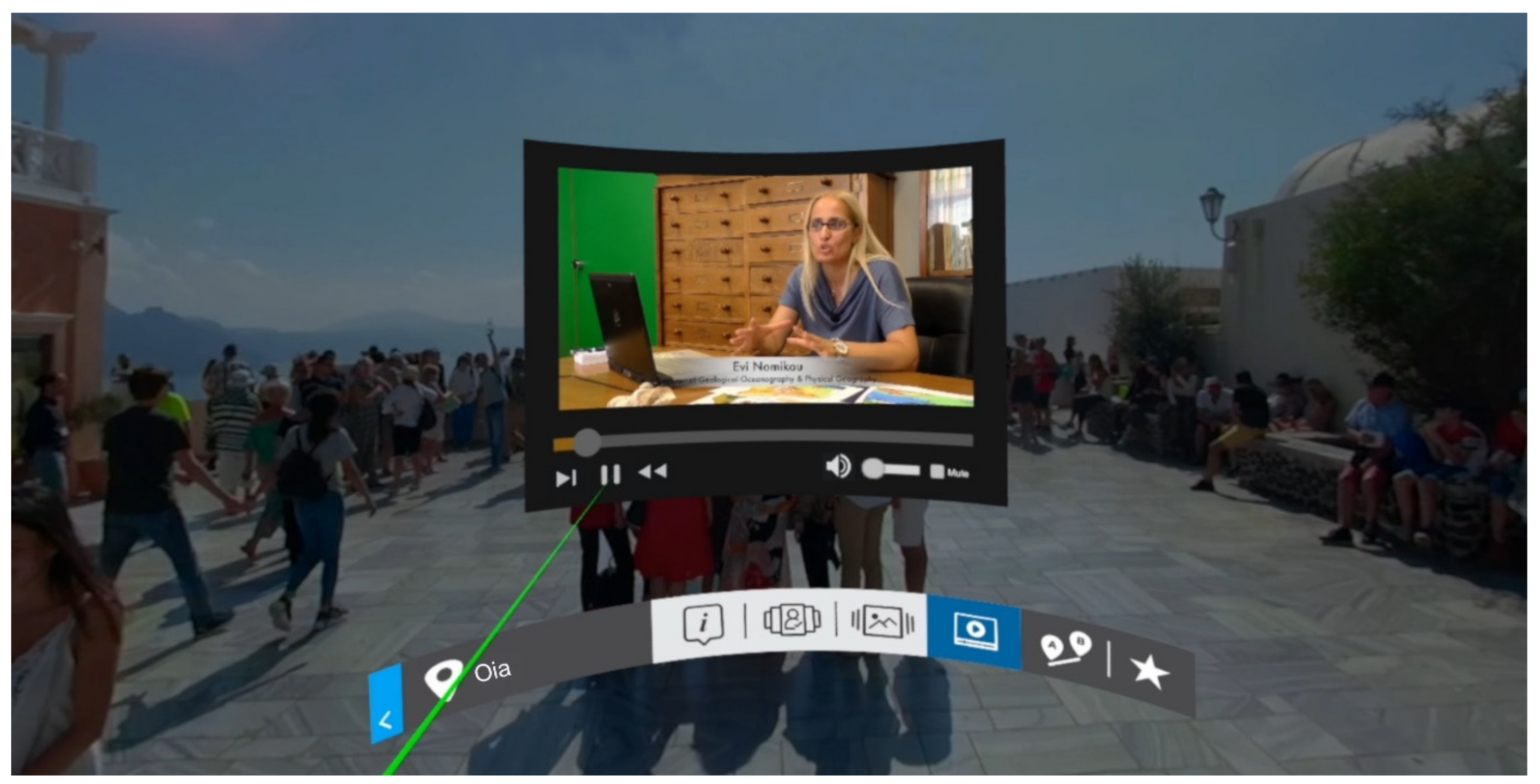
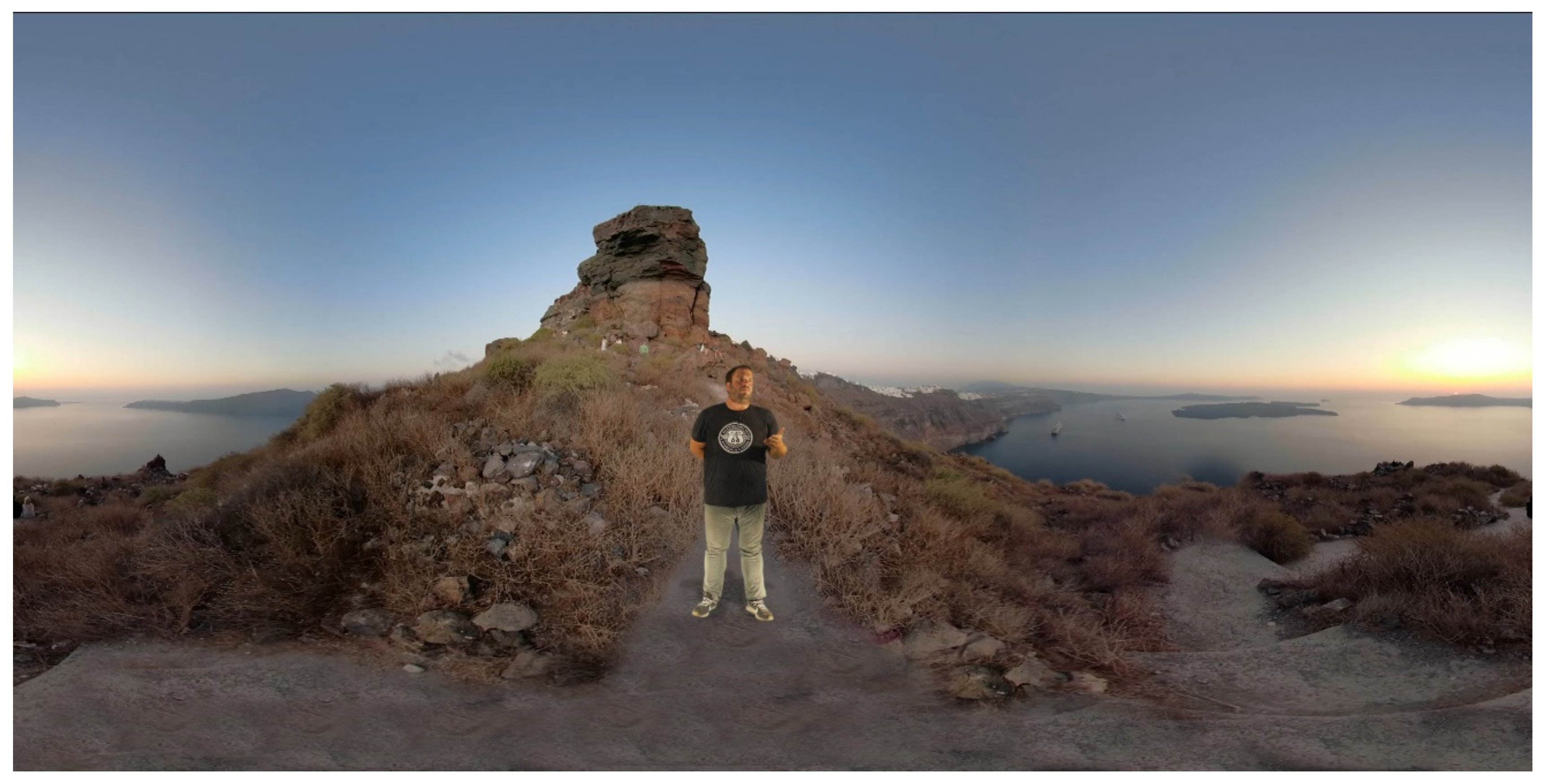
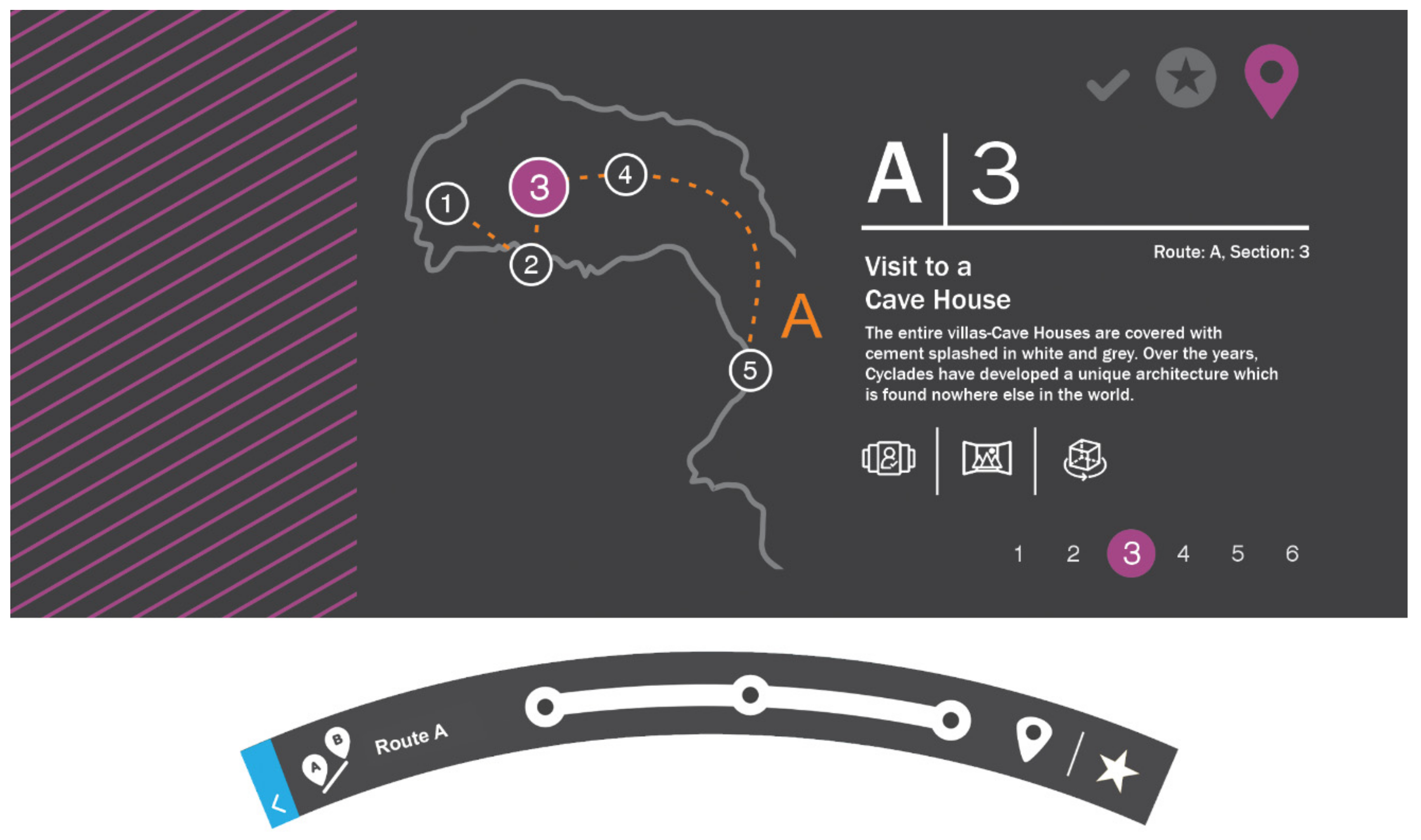
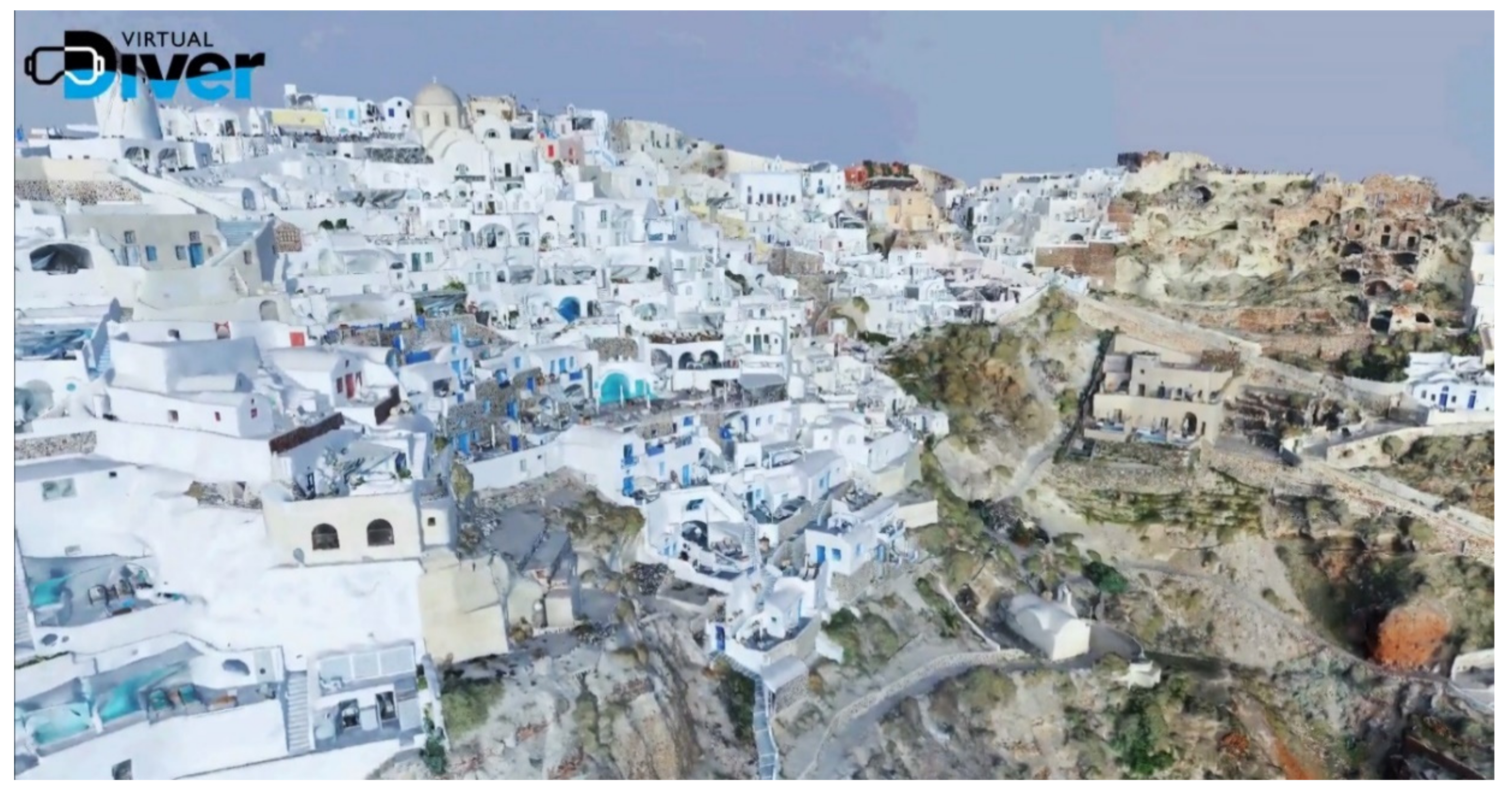

Publisher’s Note: MDPI stays neutral with regard to jurisdictional claims in published maps and institutional affiliations. |
© 2020 by the authors. Licensee MDPI, Basel, Switzerland. This article is an open access article distributed under the terms and conditions of the Creative Commons Attribution (CC BY) license (http://creativecommons.org/licenses/by/4.0/).
Share and Cite
Pehlivanides, G.; Monastiridis, K.; Tourtas, A.; Karyati, E.; Ioannidis, G.; Bejelou, K.; Antoniou, V.; Nomikou, P. The VIRTUALDiver Project. Making Greece’s Underwater Cultural Heritage Accessible to the Public. Appl. Sci. 2020, 10, 8172. https://doi.org/10.3390/app10228172
Pehlivanides G, Monastiridis K, Tourtas A, Karyati E, Ioannidis G, Bejelou K, Antoniou V, Nomikou P. The VIRTUALDiver Project. Making Greece’s Underwater Cultural Heritage Accessible to the Public. Applied Sciences. 2020; 10(22):8172. https://doi.org/10.3390/app10228172
Chicago/Turabian StylePehlivanides, George, Kostas Monastiridis, Alexandros Tourtas, Elli Karyati, Giotis Ioannidis, Konstantina Bejelou, Varvara Antoniou, and Paraskevi Nomikou. 2020. "The VIRTUALDiver Project. Making Greece’s Underwater Cultural Heritage Accessible to the Public" Applied Sciences 10, no. 22: 8172. https://doi.org/10.3390/app10228172
APA StylePehlivanides, G., Monastiridis, K., Tourtas, A., Karyati, E., Ioannidis, G., Bejelou, K., Antoniou, V., & Nomikou, P. (2020). The VIRTUALDiver Project. Making Greece’s Underwater Cultural Heritage Accessible to the Public. Applied Sciences, 10(22), 8172. https://doi.org/10.3390/app10228172







